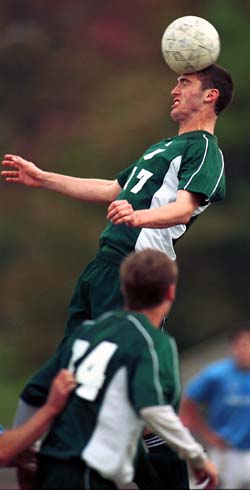Soccer is the most popular team sport in the world, boasting more than 200 million players who avidly chase, kick and head a one-pound pressurized ball in the hope of scoring that coveted GOAL!
But a multidisciplinary team of University researchers is now trying to determine whether that heading technique might have some unwelcome consequences.

The group’s concern is two-fold. Some recent studies have indicated a short-term cognitive decline in players immediately after heading. At the same time, physicians remain uncertain about the risks of long-term cognitive degeneration, a condition likened to the dementia pugilistica that afflicts boxers.
Studying the “impact” of soccer heading on the brain are Lawrence M. Lewis, M.D., associate professor of medicine, Rosanne Naunheim, M.D., assistant professor of medicine, and Carl Lauryssen, M.D., associate professor of neurological surgery, all in the School of Medicine.
Joining them are Philip V. Bayly, Ph.D., associate professor, and Guy M. Genin, Ph.D., assistant professor, both in the Department of Mechanical Engineering in the School of Engineering & Applied Science; and John Standeven, Ph.D., engineer in the Barnes-Jewish Hospital Human Performance Lab.
“What got us interested in soccer heading is that it’s a really good example of mild head impact,” Bayly said. “If you say to a typical person, ‘OK, I’m going to throw a one-pound object at you from 50 yards away, why don’t you get hit in the head with it?’ — most of us would decline.”
The chief danger is that the act of soccer heading involves both linear and angular accelerations — changes in velocity over time. But where linear accelerations happen in a straight line, angular accelerations involve rotation.
“We know for a fact that rotation of the brain has been shown to cause the most injury,” said Naunheim, pointing to an animal study conducted in the 1960s at the National Institutes of Health that demonstrated that if head rotation was limited by use of a cervical collar, subjects could sustain significantly greater impacts without receiving concussions. “So, if you prevent rotation, you decrease the likelihood of injury.”
Lewis added, “Unfortunately, even impacts that are fairly straight-on-center can result in angular acceleration in certain parts of the brain because of the way the brain is tethered to certain parts of the skull.”
Though the exact physiological events accompanying head impact are still unknown, scientists and physicians hypothesize that, as the head undergoes rotation, the brain experiences a shear force — that is, a tangentially applied force causing deformation.
“As the skull rotates, the brain twists, or shears, as it catches up,” Naunheim said. “Think of a grape in a bowl of Jell-O; as you shake the bowl, the most significant shear occurs at the interface of the grape and the Jell-O (and eventually causes) either the grape to tear free or the Jell-O to tear near the interface.
“Similarly in the brain, the junctions of gray and white matter — the areas where blood vessels penetrate and where the hemispheres come in contact with the brain stem — are areas where shear is most intense.”
Merging science & sport
Naunheim and Lewis have studied head injuries since the early 1990s, when they were colleagues in the Emergency Medicine Division at Saint Louis University Hospital. They explain that what makes soccer a unique sport in terms of injuries is that, in addition to accidental head impacts from hitting the ground, other players or a goalpost, heading is an accepted part of the game.
What they did not know — since a quantitative assessment had never been made — was what a person’s head undergoes physically when it strikes a soccer ball.
Working with the medical school team, mechanical engineers Genin and Bayly devised a series of experiments to determine the exact forces and accelerations on the head.
Four adult male test subjects between the ages of 25-36 — all of whom had played soccer in high school (including Bayly) — headed soccer balls ejected from a machine at various speeds.
Each of the test subjects wore a headpiece (designed by mechanical engineering student Jeremy Neubauer) equipped with three “accelerometers,” small devices that directly measure accelerations in the x, y and z directions.
What the researchers discovered were linear accelerations in the realm of 15-20 G’s, or about 200 meters per second squared, and angular accelerations of 1,000-2,000 radians (one radian is about 60 degrees, or one-sixth of a revolution) per second squared.
These are values well below established thresholds for acute injury.
Still, what is not known is whether repeated below-threshold impacts could result in cumulative brain damage. And some research suggests that players who define themselves as “headers” do suffer from short-term cognitive effects.
“There’s a Dutch study in the Journal of the American Medical Association in 1999 that compares runners, swimmers and soccer players,” Genin said. “Soccer players, who head the ball and are more likely to receive concussions, indeed appear to show cognitive deficits when compared to swimmers and runners with similar training regimens.”
So, pending further research, what are the group’s recommendations?
“I agree with the American Academy of Pediatrics that children under 12 should not head the ball,” concluded Naunheim, explaining that children’s heads have a lower mass relative to the ball, and that their large heads (relative to their bodies) make them more unstable after heading.
“As for older players, I think the risk will eventually be shown to be greatest for those with previous concussions.”
Related story: Univeristy researchers examine the effectiveness of headbands intended to protect soccer players from injuries